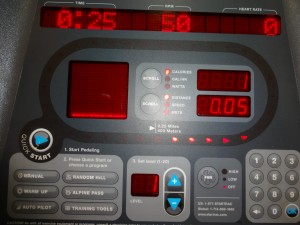When you begin to use an aerobic exercise machine, you should do so with purpose. Have a goal in mind! You can start by targeting your optimal heart rate. After a few practice attempts with the machines, you should be able to find the right intensity level that allows you to stay within your target range.
We want you to exercise at a moderate intensity or approximately 55-60% of your maximum heart rate (HR). This is a generic guideline that must be individually-tailored based on your age. You can calculate this yourself. Try this formula:
Max HR = [ 220 beats per minute – your age ]
For example, if you are 50 years old, you would calculate 220-50 = 170. In theory, 170 is your max HR or the max total number of heart beats per minute (BPM) you can achieve. We recommend that you aim to maintain a level of 55-60% of your Max HR for the duration of your workouts. Specifically, for a 50-yr-old, that’s between 94 to 102 BPM.
The best way to measure your HR is to take your own pulse for 10 seconds and multiple by 6 to get an estimation of your current BPM. You can use the sensors on the machines but they tend to be inaccurate (e.g., occasionally off by as much as +/- 40 BPM). You may want to purchase an HR monitor. Watches with chest straps (e.g., Polar, Nike) are usually fairly accurate.
During your early sessions, we expect that you might reach 60% relatively quickly. This will happen for any previously inactive adults (>3 months) engaging in moderately intense exercise. It will take time to build your aerobic endurance. Be patient and simply do the best you can. As you develop a regular aerobic exercise routine, in several weeks, you should find that you can do more and your HR may become less sensitive to exercise (a signal of increased fitness). Some of you may be able to consistently exceed 55-60%, without feeling fatigued. This just means you have better aerobic capacity and perhaps you have had years of prior experience. After a brief 3-5 minute warm-up we encourage you to at least maintain 55-60% throughout your workout. If you want to do more, that’s up to you.
Important Advice
Keep in mind that many things can affect HR, including prior physical activity (e.g., stairs), medications, caffeine consumption, and stress. All of these should be considered while adjusting your exercise intensity level. For example, you may be taking BP medication and unable to elevate your HR. If this situation describes you, don’t try to compensate lack of HR change by increasing your intensity level.
Simply try to make the most out of your aerobic sessions. You should “feel it” but you may or may not sweat. You should be able to talk briefly while exercising, but long conversations with the person next to you may bring down your intensity level. The best way to do this is to find your target HR and monitor it. Just don’t stress if it goes a little above or stays below despite your hard effort.
Advice to all: Move at a pace that’s comfortable but that provides an optimal challenge.
